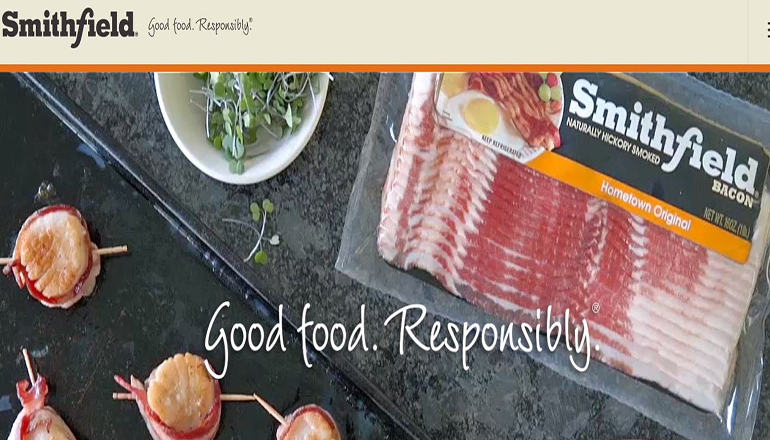Smithfield Foods, Inc. announces, through the nationwide expansion of Smithfield Renewables, innovative projects designed to help meet its goal to reduce the company’s greenhouse gas emissions 25 percent by 2025, which it set in concert with the Environmental Defense Fund (EDF). This month marks the one-year anniversary of Smithfield Renewables.
As part of the expansion of Smithfield Renewables, Smithfield is:
- Setting the ambitious goal to implement “manure-to-energy” projects across 90 percent of Smithfield’s hog finishing spaces in North Carolina and Utah, and nearly all Smithfield’s hog finishing spaces in Missouri over the next ten years. This timeline will aid the company in achieving—and exceeding—its 25 by ’25 commitment.
- Converting existing anaerobic treatment lagoons to covered digesters or constructing newly covered digesters to capture biogas, which will be transported to central processing facilities to be converted into a renewable natural gas in North Carolina, Missouri, and Utah.
- Launching new programs that target GHG reductions and bolster Smithfield’s sustainability efforts at farms, plants, and throughout the company’s transportation network.
“When we set an objective, we go big at Smithfield to achieve it. Today’s announcement is the culmination of decades spent studying and perfecting the commercial viability of ‘manure-to-energy’ projects. Our investment in these projects underscores our longstanding commitment to sustainability, as well as our promise to produce good food in a responsible way,” said Kenneth M. Sullivan, president, and chief executive officer of Smithfield Foods.
He continued, “The scale of these projects is audacious. But, through partnerships with a broad coalition of stakeholders, including family farmers, government, energy partners, and other constituents, we’re confident we can bring about sustainable, revolutionary progress in our effort to minimize our environmental footprint.”
“Smithfield is demonstrating leadership by investing in solutions that build climate resilience and cut greenhouse gas emissions. Smithfield’s commitment to deploy technologies that convert methane into renewable biogas will substantially reduce emissions of a powerful greenhouse gas and create economic opportunities for rural communities. This commitment marks a welcome turning point for the industry,” said Fred Krupp, president of EDF.
With a longstanding commitment to innovation and continuous improvement, Smithfield has been researching and exploring sustainable ways to transform manure into energy for many years.
“Now, thanks to the dedication of our team members, technological advancements, and a viable market for RNG, ‘manure-to-energy’ projects are a sustainable endeavor for hog farms,” said Stewart Leeth, vice president of regulatory affairs and chief sustainability officer for Smithfield Foods. “We are proud to expand our efforts across the country, shrinking our environmental footprint and investing in the protection of our planet’s resources.”
In Missouri, Smithfield and Roeslein Alternative Energy are embarking on a joint venture to launch the second phase of a project that currently converts manure collected from company-owned farms into RNG, enough to power 15,400 homes per year. By the end of this phase, Smithfield and RAE will have jointly installed biogas infrastructure across all company-owned finishing farms in Missouri. In ten years, nearly 100 percent of Smithfield’s company-owned hog finishing spaces in Missouri will have the capabilities to produce RNG.
“Missouri farmers play a major role in meeting world food demand and strengthening our state’s economy,” said U.S. Senator Roy Blunt. “This initiative will also enhance their contribution to our energy security. I appreciate all our farmers and energy producers do to support jobs and growth in local communities and keep our ag industry thriving.”
In addition to using manure to create RNG, this project will harvest prairie grass for methane generation. The harvested grasses, which supplement the biogas generation particularly during the cold winter months, are part of a prairie restoration effort that Smithfield has supported in Northern Missouri for some time. Earlier this year, Smithfield expanded its support for these efforts by becoming the first food company to participate in EDF’s Monarch Butterfly Exchange, a program that restores monarch butterfly habitats on private lands including Smithfield hog farms in Missouri.
“From their leadership in creating renewable energy to conservation, Smithfield is changing what it means to be a food company,” said Rudi Roeslein, president of RAE. “Smithfield’s willingness to embrace the power of prairie proves the industry can play a meaningful role in seizing the economic benefits of conservation.”
While we have much to be proud of in our first year, we are excited about the significant opportunities ahead,” said Kraig Westerbeek, senior director of Smithfield Renewables. “I am confident that we will build on our momentum in the coming years and long after 2025.”
An internal advisory committee evaluates these and future projects to ensure the company remains on track in meeting its GHG reduction goal and other renewable efforts. To learn more about Smithfield Renewables, please visit smithfieldfoods.com/renewables.







